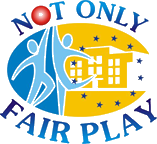
- Home
- Best
Practices - Toolkits
How to ... - Sport
Events - Guidelines
- Information
& Contacts - Project Management
A collection of student stories and initiatives about sport.
This section offers access to a collection of toolkits to promote sport at school.
-
 Physical Education Teachers
They are the main point of reference for students at school
Physical Education Teachers
They are the main point of reference for students at school
-
 Teachers
Teachers of all subjects can contribute to promote sport at school
Teachers
Teachers of all subjects can contribute to promote sport at school
-
 School Directors
Their support is a key element to promote sport at school
School Directors
Their support is a key element to promote sport at school
-
 Resources
A database of resources for teachers, PE teachers and school directors for the promotion of sport at school.
Resources
A database of resources for teachers, PE teachers and school directors for the promotion of sport at school.
Sporting events are organised in each partner country
Guidelines for policy makers willing to raise awareness on the importance of promoting sport in schools
Events
The Not Only Fair Play project has been promoted through conferences and articles.
Partnership
-
 Contractual Partners
From this section it is possible to access a description of each contractual partner of the Not Only Fair Play project.
Contractual Partners
From this section it is possible to access a description of each contractual partner of the Not Only Fair Play project.
-
 Schools
From this section it is possible to access information about the schools involved in the Not Only Fair Play Project in the 9 European countries involved.
Schools
From this section it is possible to access information about the schools involved in the Not Only Fair Play Project in the 9 European countries involved.
-
 Associated Partners
A number of associated partners officially joined the project in order to ensure the project sustainability by continuing to use the project deliverables over the next years.
Associated Partners
A number of associated partners officially joined the project in order to ensure the project sustainability by continuing to use the project deliverables over the next years.
This section of the Not Only Fair Play portal provides administrative information for the project contractual partners and for the European Commission, and is password protected.
School Directors
Homepage > Toolkits > School Directors

Their support is a key element to promote sport at school
Back to the School Directors Toolkits
How to Integrate Sport into Curricular Activities
School Director
School staff: Reasons for the stakeholders to be interested in supporting PE curriculum change
• Improved physical health of the students;
• Improved overall health status of the school;
• Reduced absenteeism due to illness of students;
• Improved tests scores and academic performance of students;
• Increased attention span, reduction in behavioral problems and improved mood of students.
School staff: Potential role of the stakeholder in supporting PE curriculum change
• Implement physical activity in classrooms;
• Implement physical activity into school day (lunch, before and after school);
• Support for the school’s physical activity initiatives;
• Help design policy and systems change in the school.
PE teachers: Reasons for the stakeholders to be interested in supporting PE curriculum change
• Improved physical health and fitness of students;
• Improved class performance;
• Increased student participation and interest in physical education classes;
• Increased variety of activities offered ;
• Increased motivation among students and their families to be physically active;
PE teachers: Potential role of the stakeholder in supporting PE curriculum change
• Be a role model of good physical activity habits for students;
• Implement new physical activity policy in class and encourage other teachers to do the same;
• Provide educational aspect of the importance of daily physical activity to students;
• Provide physical activity resources to students and their families;
• Donate equipment or gym resources;
• Provide parents with information on physical activity and its benefits;
• Serve as a reference point for other school faculty and staff when planning physical activities;
• Provide resources and training to school staff on physical activities;
• Host family fitness fun nights to expose students and their families to quality physical activity experiences
Parents: Reasons for the stakeholders to be interested in supporting PE curriculum change
• Increased physical activity of their child;
• Reduced risk of overweight/obesity of their child
• Improved overall health of their child
• Formation of a healthier home
• Improved academic performance of their child
• Improved self-esteem, mood and motivation of their child.
• Be a role model of good physical activity habits
• Donate physical activity materials to school
• Volunteer time to lead physical activity during, after or before school
• Provide motivation to school
• Help with promotion of school’s PE initiatives
Community members: Potential role of the stakeholder in supporting PE curriculum change
• Be a role model of good physical activity habits for students;
• Donate finances or materials to school’s physical activity efforts;
• Help with media and advertising of school’s sports initiatives
• Provide networking with other potential partnering organizations;
• Provide tools and resources from their field of expertise;
• Be an outside voice and perspective on the physical activity initiatives.
Doctors of the kids/Medical personnel in school: Reasons for the stakeholders to be interested in supporting PE curriculum change
• Decreased illness and absenteeism due to illness;
• Improved health and decreased health risks of students;
• Better health scores on tests of students;
• Increased motivation among students and their families to be physically active;
• Improved health status of their patients.
Doctors of the kids/Medical personnel in school: Potential role of the stakeholder in supporting PE curriculum change
• Be a role model of good physical activity habits for students;
• Provide educational aspect of physical activity to students;
• Provide parents with information on physical activity and health benefits;
• Serve as a reference point for other school faculty and staff when planning physical activities;
• Encourage students and parents to be more physically active
- Promoting healthy youthGuidelines on how to work with the schools and the community in order to support physical activities and healthy living.
- School policy frameworkDocument analyzing school policies in terms of PE, with attention to joint work with different stakeholders from outside of the school.
- Expert Group on Health-enhancing physical activityRecommendations to encourage physical education in schools, including motor skills in early childhood, and to create valuable interactions with the sport sector, local authorities and the private sector
- Young people: Practical strategies for promoting physical activityThe purpose of this briefing is to provide commissioners, physical activity and health professionals and school staff with evidence-based recommendations and practical strategies to consider when planning, developing and delivering activities to promote physical activity in young people, ie, those aged 11-18 years old.


